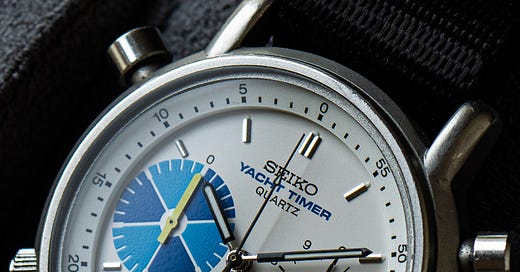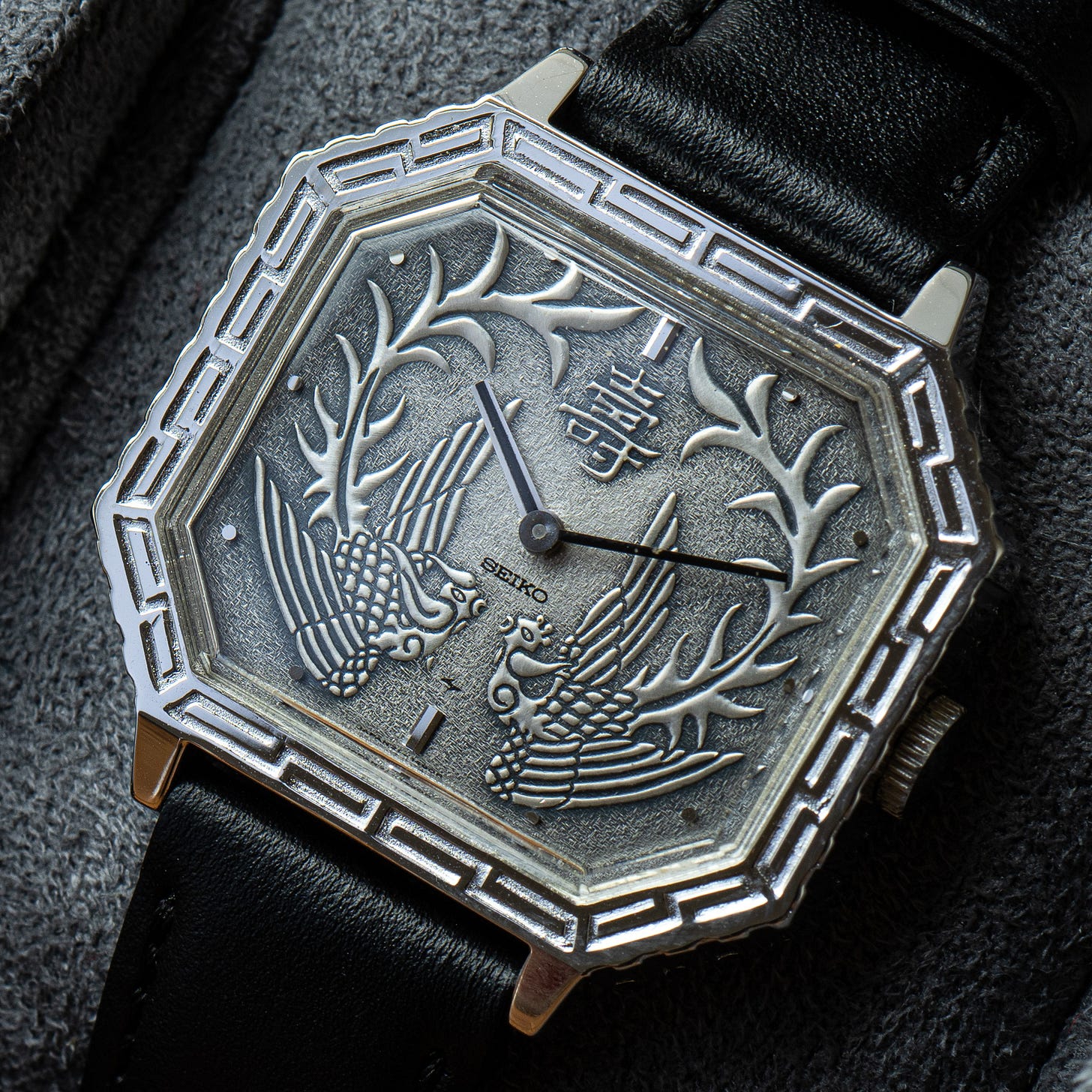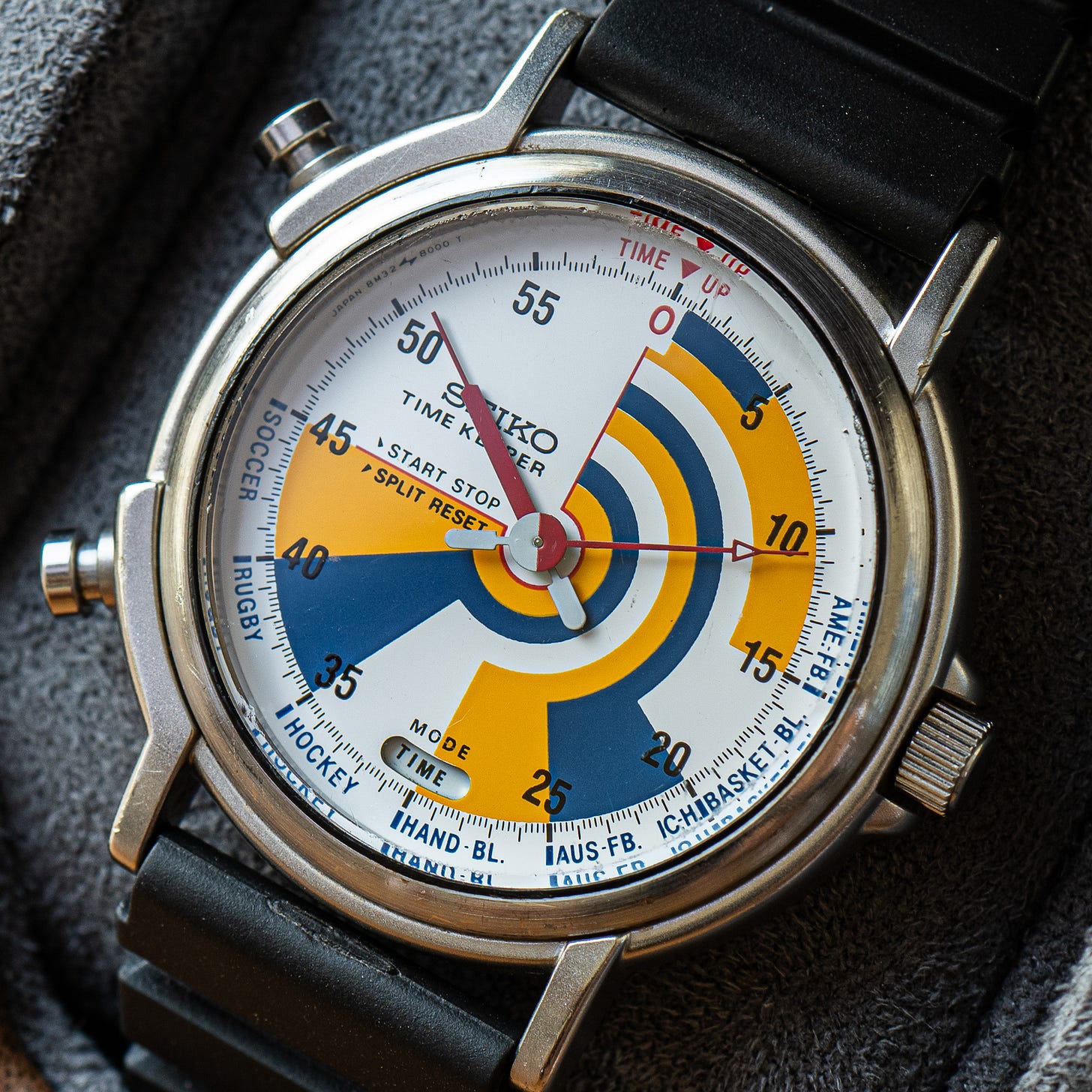Classics, Chronographs... and a Classic Chronograph
If the 7A28 Yacht Timer isn't in your top 10 Seiko list, let me try to change your mind!
The Precursor
Quartz; a touchy subject. If you believe the scary stories Swiss watchmakers tell each other around the campfire, Seiko almost destroyed the entire watch industry when it invented the battery powered, quartz regulated movements in 1969. The watch industry miraculously didn’t implode, and Seiko spend the better part of the 1980s creating some seriously cool quartz references, both in terms of looks and features. I’m excited to be able to share some of those today.
Seiko 7A28-7090 “Yacht Timer”
It goes without saying that my esteemed readers and I all have yachts that need timing. And is there a more suitable candidate for such a task than the 1983 Seiko Yacht Timer? Only produced for a couple of years in the early 80s, the look has become iconic. There’s something magical about the imbalance of the subdials’ colour and design elements, coupled with imbalanced crowns and chrono-pushers. It somehow looks very utilitarian, and yet so graceful all at once.
The 7A28 movement itself is a historic piece - the first quartz analogue chronograph in the world. Understandably, the price of these has shot up over the last 15 years. Historic and cool. Not an easy combination to pull off! The opportunity to buy a 40+ year old quartz in great condition doesn’t come up often, especially when you consider the short production time of the 7A28-7090. This has just been serviced and is in perfect working order.
Seiko 21-3210 “Kotobuki” Silver Emperor Watch
I gilded the lily of the gold version of this watch in last week’s newsletter, so I’ll try to cover new ground. In all my 21-3210 related waffle, I didn't discuss the meaning behind the two animals on the dial. This watch was made in 1973 to celebrate Emperor Hirohito's upcoming 50th Wedding Anniversary. Often simply referred to as 寿 in Japan, which means "Kotobuki" or Congratulations/Long life.
Interestingly, "Kotobuki" is also the word for a mythical Japanese creature creature that is depicted as being a combination of all the animals from the Chinese zodiac. Therefore, the dial is adorned with two Kotobuki as a way to offer congratulations and a long life to the Emperor.
Like the Gold Emperor from last week, this also has the original spare dial, price tags and box! The box is covered in a beautiful folded red velvet with a gold accented Kotobuki on the inside.
Seiko 8M32-8000 “Sports Timer” Chronograph
I could write an entire article about this bizarre but amazing watch. Released in the late 1980s and it absolutely looks the part. A wonderful array of colours and patterns adorn the dial with such confidence that you almost assume the shape has some sort of meaning. It absolutely doesn’t, but you’ve got to admire the punchiness of this design choice. I love the sports around the edge of the dial; each one positioned next to the minutes that signify one half or quarter of play in the respective sport.
The oddities don’t stop at the visuals though. It’s a chronograph with just an hour and minute hand. But a chronograph without a second hand to count the seconds is stupid. Luckily Seiko agrees! When you turn the crown to “Chronograph” mode the minute hand becomes a second hand, and the hour hand becomes a minute hand. Flick it back to “Time” mode and the hands effortlessly glide back into their respective temporal places. But perhaps the oddest mode is “Timer” mode; the pushers are used to set a timer between 1-60 minutes, and an alarm sounds at the end. Pretty straightforward. The odd part? The hands tick backwards. It’s a true countdown timer. This is essentially a digital watch with an analogue face (and a great looking analogue face at that).
Seiko SCVF009 “Red” Alpinist
The impossible task of introducing a watch that needs absolutely no introduction. The “if-you’re-going-to-copy-my-homework-please-change-it-a-little-bit” Alpinist that all future Alpinists resemble quite a bit. You can’t blame them though - it’s an enviable design. And while I do like the SARB017 and SPB121 Alpinists, I can’t help but feel they’re missing the special finishing touch that the bright red “Alpinist” brings to the SCVF’s dial.
Not only do the modern Alpinists come up short in the looks department, there’s also the movement comparison that is hard to ignore. The SCVF series has the impressive 4S15 28,800 bph (“Hi-Beat”) movement; solid, reliable, with a smoother sweeper. The SARB017 has the normal bph and often maligned 6R15 movement, and the SPB121 has the 6R35 which is essentially just a power reserve upgrade of the 6R15.
Credor Titanium 2F70-5130
An ultra-slim Credor dress watch, made from precious materials. Credor has a long history as Seiko’s “precious material” sister company. Founded in 1974, and deriving its name from "Crête d'Or" (French for “height/pinnacle of gold”), Credor set out to create dress watches using precious metals and stones. Now, Credor is more well-known for its extraordinary craftsmanship and otherworldly finishing.
Released in the early 90s, and like a lot of Credors, it was only sold in Japan. The case and bracelet are titanium, and the dial accents and hands are 18k gold, and the crystal is sapphire. Three precious materials packed into a 4.6mm tall watch - not bad! Being quartz, titanium and slim, it’s incredibly lightweight and effortless to wear.
Don’t forget to follow my Instagram to see all of the watches above in full cinematic glory.









